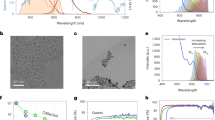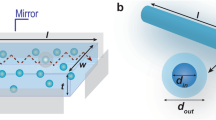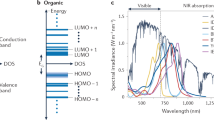Abstract
The transition to fully energetically sustainable architecture through the realization of so-called net zero-energy buildings is currently in progress in areas with low population density. However, this is not yet true in cities, where the cost of land for the installation of ground photovoltaic (PV) is prohibitively high and the rooftop space is too scarce to accommodate the PV modules necessary for sustaining the electrical requirements of tall buildings. Thus, new technologies are being investigated to integrate solar-harvesting devices into building façades in the form of PV windows or envelope elements. Luminescent solar concentrators (LSCs) are the most promising technology for semi-transparent, electrodeless PV glazing systems that can be integrated ‘invisibly’ into the built environment without detrimental effects to the aesthetics of the building or the quality of life of the inhabitants. After 40 years of research, recent breakthroughs in the realization of reabsorption-free emitters with broadband absorption have boosted the performance of LSCs to such a degree that they might be commercialized in the near future. In this Perspective, we explore the successful strategies that have allowed this change of pace, examining and comparing the different types of chromophores and waveguide materials, and discuss the issues that remain to be investigated for further progress.
This is a preview of subscription content, access via your institution
Access options
Access Nature and 54 other Nature Portfolio journals
Get Nature+, our best-value online-access subscription
$29.99 / 30 days
cancel any time
Subscribe to this journal
Receive 12 digital issues and online access to articles
$119.00 per year
only $9.92 per issue
Buy this article
- Purchase on Springer Link
- Instant access to full article PDF
Prices may be subject to local taxes which are calculated during checkout



Similar content being viewed by others
References
Jelle, B. P., Breivik, C. & Røkenes, H. D. Building integrated photovoltaic products: a state-of-the-art review and future research opportunities. Sol. Energ. Mater. Sol. Cells 100, 69–96 (2012).
The European Parliament and the Council of the European Union. Directive 2010/31/EU of the European Parliament and the Council on the energy performance of buildings (recast). Off. J. Eur. Union 18, 13–35 (2010).
Debije, M. G. Solar energy collectors with tunable transmission. Adv. Funct. Mater. 20, 1498–1502 (2010).
van Sark, W. G. J. H. M. Luminescent solar concentrators — a low cost photovoltaics alternative. Renewable Energy 49, 207–210 (2013).
Meinardi, F. et al. Large-area luminescent solar concentrators based on Stokes-shift-engineered nanocrystals in a mass-polymerized PMMA matrix. Nat. Photonics 8, 392–399 (2014).
Meinardi, F. et al. Highly efficient luminescent solar concentrators based on earth-abundant indirect-bandgap silicon quantum dots. Nat. Photonics 11, 177–185 (2017).
Meinardi, F. et al. Highly efficient large-area colourless luminescent solar concentrators using heavy-metal-free colloidal quantum dots. Nat. Nanotechnol. 10, 878–885 (2015).
Weber, W. H. & Lambe, J. Luminescent greenhouse collector for solar radiation. Appl. Opt. 15, 2299–2300 (1976).
Goetzberger, A. & Greube, W. Solar energy conversion with fluorescent collectors. Appl. Phys. A Mater. Sci. Process. 14, 123–139 (1977).
Saifullah, M., Gwak, J. & Yun, J. H. Comprehensive review on material requirements, present status, and future prospects for building-integrated semitransparent photovoltaics (BISTPV). J. Mater. Chem. A 4, 8512–8540 (2016).
Debije, M. G. & Verbunt, P. P. C. Solar concentrators: thirty years of luminescent solar concentrator research: solar energy for the built environment. Adv. Energy Mater. 2, 12–35 (2012).
Pietryga, J. M. et al. Spectroscopic and device aspects of nanocrystal quantum dots. Chem. Rev. 116, 10513–10622 (2016).
Yablonovitch, E. Thermodynamics of the fluorescent planar concentrator. J. Opt. Soc. Am. 70, 1362–1363 (1980).
Currie, M. J., Mapel, J. K., Heidel, T. D., Goffri, S. & Baldo, M. A. High-efficiency organic solar concentrators for photovoltaics. Science 321, 226–228 (2008).
van Sark, W. G. J. H. M. et al. Luminescent solar concentrators — a review of recent results. Opt. Express 16, 21773–21792 (2008).
Banal, J. L., Ghiggino, K. P. & Wong, W. W. H. Efficient light harvesting of a luminescent solar concentrator using excitation energy transfer from an aggregation-induced emitter. Phys. Chem. Chem. Phys. 16, 25358–25363 (2014).
Portnoi, M., Sol, C., Tummeltshammer, C. & Papakonstantinou, I. Impact of curvature on the optimal configuration of flexible luminescent solar concentrators. Opt. Lett. 42, 2695–2698 (2017).
Aste, N., Tagliabue, L. C., Del Pero, C., Testa, D. & Fusco, R. Performance analysis of a large-area luminescent solar concentrator module. Renewable Energy 76, 330–337 (2015).
Slooff, L. H. et al. A luminescent solar concentrator with 7.1% power conversion efficiency. Phys. Status Solidi RRL 2, 257–259 (2008).
Debije, M. G., Tzikas, C., Rajkumar, V. A. & de Jong, M. M. The solar noise barrier project: 2. The effect of street art on performance of a large scale luminescent solar concentrator prototype. Renew. Energy 113, 1288–1292 (2017).
van Sark, W. et al. The “electric Mondrian” as a luminescent solar concentrator demonstrator case study. Solar RRL 1, 1600015 (2017).
Batchelder, J. S., Zewai, A. H. & Cole, T. Luminescent solar concentrators. 1: Theory of operation and techniques for performance evaluation. Appl. Opt. 18, 3090–3110 (1979).
Desmet, L., Ras, A. J. M., de Boer, D. K. G. & Debije, M. G. Monocrystalline silicon photovoltaic luminescent solar concentrator with 4.2% power conversion efficiency. Opt. Lett. 37, 3087–3089 (2012).
Debije, M. G. et al. Promising fluorescent dye for solar energy conversion based on a perylene perinone. Appl. Opt. 50, 163–169 (2011).
Sanguineti, A. et al. High Stokes shift perylene dyes for luminescent solar concentrators. Chem. Commun (Camb.) 49, 1618–1620 (2013).
Krumer, Z. et al. Tackling self-absorption in luminescent solar concentrators with type-II colloidal quantum dots. Sol. Energy Mater. Sol. Cells 111, 57–65 (2013).
Shcherbatyuk, G. V., Inman, R. H., Wang, C., Winston, R. & Ghosh, S. Viability of using near infrared PbS quantum dots as active materials in luminescent solar concentrators. Appl. Phys. Lett. 96, 191901 (2010).
Bomm, J. et al. Fabrication and full characterization of state-of-the-art quantum dot luminescent solar concentrators. Sol. Energy Mater. Sol. Cells 95, 2087–2094 (2011).
Sanguineti, A. et al. NIR emitting ytterbium chelates for colourless luminescent solar concentrators. Phys. Chem. Chem. Phys. 14, 6452–6455 (2012).
Wang, T. et al. Luminescent solar concentrator employing rare earth complex with zero self-absorption loss. Sol. Energy 85, 2571–2579 (2011).
Zhou, Y. et al. Near infrared, highly efficient luminescent solar concentrators. Adv. Energy Mater. 6, 1501913 (2016).
Bronstein, N. D. et al. Luminescent solar concentration with semiconductor nanorods and transfer-printed micro-silicon solar cells. ACS Nano 8, 44–53 (2013).
Talapin, D. V. et al. Seeded growth of highly luminescent CdSe/CdS nanoheterostructures with rod and tetrapod morphologies. Nano Lett. 7, 2951–2959 (2007).
Bronstein, N. D. et al. Quantum dot luminescent concentrator cavity exhibiting 30-fold concentration. ACS Photonics 2, 1576–1583 (2015).
Erickson, C. S. et al. Zero-reabsorption doped-nanocrystal luminescent solar concentrators. ACS Nano 8, 3461–3467 (2014).
Bradshaw, L. R., Knowles, K. E., McDowall, S. & Gamelin, D. R. Nanocrystals for luminescent solar concentrators. Nano Lett. 15, 1315–1323 (2015).
Meinardi, F. et al. Doped halide perovskite nanocrystals for reabsorption-free luminescent solar concentrators. ACS Energy Lett. 2, 2368–2377 (2017).
Viswanatha, R., Brovelli, S., Pandey, A., Crooker, S. A. & Klimov, V. I. Copper-doped inverted core/shell nanocrystals with “permanent” optically active holes. Nano Lett. 11, 4753–4758 (2011).
Hu, X. et al. Ray-trace simulation of CuInS(Se)2 quantum dot based luminescent solar concentrators. Opt. Express 23, A858–A867 (2015).
Knowles, K. E., Kilburn, T. B., Alzate, D. G., McDowall, S. & Gamelin, D. Bright CuInS2/CdS nanocrystal phosphors for high-gain full-spectrum luminescent solar concentrators. Chem. Commun. (Camb.) 51, 9129–9132 (2015).
Chen, W. et al. Heavy metal free nanocrystals with near infrared emission applying in luminescent solar concentrator. Solar RRL 1, 1700041 (2017).
Meier, C., Gondorf, A., Lüttjohann, S., Lorke, A. & Wiggers, H. Silicon nanoparticles: absorption, emission, and the nature of the electronic bandgap. J. Appl. Phys. 101, 103112 (2007).
Hannah, D. C. et al. On the origin of photoluminescence in silicon nanocrystals: pressure-dependent structural and optical studies. Nano Lett. 12, 4200–4205 (2012).
Zhao, Y. & Lunt, R. R. Transparent luminescent solar concentrators for large-area solar windows enabled by massive Stokes-shift nanocluster phosphors. Adv. Energy Mater. 3, 1143–1148 (2013).
Colby, K. A. et al. Electronic energy migration on different time scales: concentration dependence of the time-resolved anisotropy and fluorescence quenching of Lumogen Red in poly(methyl methacrylate). J. Phys. Chem. A 114, 3471–3482 (2010).
Zettl, M., Mayer, O., Klampaftis, E. & Richards, B. S. Investigation of host polymers for luminescent solar concentrators. Energy Technol. 5, 1037–1044 (2017).
Kastelijn, M. J., Bastiaansen, C. W. M. & Debije, M. G. Influence of waveguide material on light emission in luminescent solar concentrators. Opt. Mater. 31, 1720–1722 (2009).
Rubin, M. Optical properties of soda lime silica glasses. Sol. Energy Mater. 12, 275–288 (1985).
Ioannides, N. et al. Approaches to mitigate polymer-core loss in plastic optical fibers: a review. Mater. Res. Express 1, 032002 (2014).
SCHOTT. Optical glass data sheets SCHOTThttps://refractiveindex.info/download/data/2015/schott-optical-glass-collection-datasheets-july-2015-us.pdf (2015).
Batchelder, J. S., Zewail, A. H. & Cole, T. Luminescent solar concentrators. 2: Experimental and theoretical analysis of their possible efficiencies. Appl. Opt. 20, 3733–3754 (1981).
Verbunt, P. P. C. et al. Controlling light emission in luminescent solar concentrators through use of dye molecules aligned in a planar manner by liquid crystals. Adv. Funct. Mater. 19, 2714–2719 (2009).
Verbunt, P. P. C., Sánchez-Somolinos, C., Broer, D. J. & Debije, M. G. Anisotropic light emissions in luminescent solar concentrators–isotropic systems. Opt. Express 21, A485–A493 (2013).
Author information
Authors and Affiliations
Contributions
F.M. researched data for article, provided substantial contribution to discussion of the content and reviewed and edited the manuscript before submission. F.B. researched data for article. S.B. researched data for article, provided substantial contribution to discussion of the content and wrote, reviewed and edited the manuscript before submission.
Corresponding authors
Ethics declarations
Competing interests
The authors declare no competing interests.
Rights and permissions
About this article
Cite this article
Meinardi, F., Bruni, F. & Brovelli, S. Luminescent solar concentrators for building-integrated photovoltaics. Nat Rev Mater 2, 17072 (2017). https://doi.org/10.1038/natrevmats.2017.72
Published:
DOI: https://doi.org/10.1038/natrevmats.2017.72
This article is cited by
-
A comprehensive dataset of photonic features on spectral converters for energy harvesting
Scientific Data (2024)
-
Luminescent solar concentrator efficiency enhanced via nearly lossless propagation pathways
Nature Photonics (2024)
-
Rapid synthesis of phosphor-glass composites in seconds based on particle self-stabilization
Nature Communications (2024)
-
Predicting the efficiency of luminescent solar concentrators for solar energy harvesting using machine learning
Scientific Reports (2024)
-
Luminescent concentrators enable highly efficient and broadband photodetection
Light: Science & Applications (2022)



